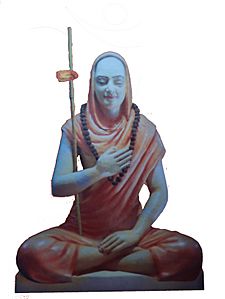Gaudapada facts for kids
Quick facts for kids Gauḍapāda |
|
|---|---|

Adi Guru Shri Gauḍapādāchārya
|
|
| Philosophy | Advaita Vedanta |
Gauḍapāda (Sanskrit गौडपाद), who lived around the 6th century CE, was an important Hindu philosopher and scholar. He was a key figure in the Vedanta school of Hindu philosophy. We don't know much about his life, but his ideas greatly inspired later thinkers. For example, Adi Shankara, another famous philosopher, called him a Paramaguru, which means "highest teacher."
Gauḍapāda's Teachings
Gauḍapāda is known for writing or putting together a significant text called the Māṇḍukya Kārikā. This book is also known as the Gaudapada Karika. It is divided into four main parts or chapters.
The Chapters of the Māṇḍukya Kārikā
The fourth chapter of the Māṇḍukya Kārikā uses some terms and ideas that come from Buddhism. This suggests that Buddhist teachings might have influenced this part of the text. However, the main message and beliefs in Gauḍapāda's work are firmly rooted in Vedanta philosophy, not Buddhism.
The first three chapters of Gauḍapāda's text have been very important for the Advaita Vedanta tradition. This is a major school of thought within Hinduism. Some parts of the first chapter, especially those that include ideas from the Mandukya Upanishad, are considered sacred and true by other Vedanta schools, like Dvaita and Vishistadvaita. But the fourth chapter, because of its Buddhist influences, is not accepted or used by these Hindu Vedanta schools.
Images for kids
See also
 In Spanish: Gaudapada para niños
In Spanish: Gaudapada para niños


